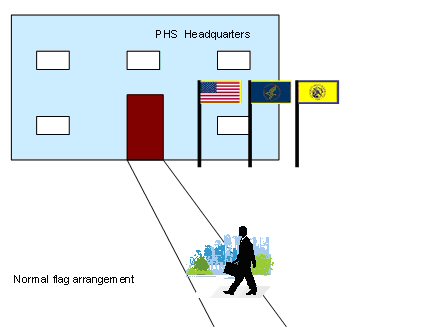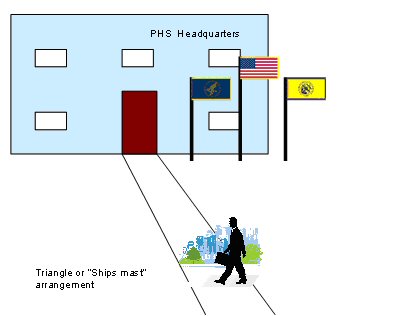|
Protocol & Etiquette Corner |
Submitted by the Office of the Surgeon General Protocol Point of Contact:
LT La Keisha C. Jones, USPHS (lakeisha.jones@hhs.gov)
|
|
Please note that information provided in this Commissioned Corps Bulletin article is intended to provide clarification for officers of the Commissioned Corps of the U.S. Public Health Service (Corps) who are coordinating, executing, and participating in Corps related activities, events, and ceremonies. In response to frequent questions received from civilians, officers, and Department of Health and Human Services (HHS) Operating Divisions, Staff Divisions, and non-HHS organizations to which Corps officers are assigned, the Office of the Surgeon General will publish monthly columns to provide clarity on topics such as, but not limited to, ceremonies and routine activities.
Please contact the Office of the Surgeon General if you have any questions or concerns regarding protocol and etiquette in the Corps –
Lakeisha.jones@hhs.gov
|
Please note the following clarifications to the May 2009 ‘Protocol & Etiquette Corner’ --
WHEN TO SALUTE:
When encountering an officer of equal or higher rank.
Clarification: It is not required to salute an officer of equal rank, but it is proper courtesy. An officer must initiate the salute when encountering an officer of higher rank (or appropriate dignitary), and must return the salute rendered by a service member of lower (or equal) rank.
WHOM TO SALUTE:
All individuals who are equal or senior to you in rank in any of the uniformed services of the United States, or of foreign governments.
Clarification: An officer must initiate the salute when encountering an officer of higher rank (or appropriate dignitary), and must return the salute rendered by a service member of lower (or equal) rank.
Note: Foreign services may wear rank that is not always familiar. A star may not always indicate a flag officer. It is best to become familiar with the rank of higher ranking officials versus the rank of enlisted equivalent if you are in contact with officials and institutions, such as the Department of State, where foreign dignitaries are present more often than not.
|
DISPLAY OF FLAGS
|
In light of the recent confirmations gaining public attention, and the number of Commissioned Corps of the U.S. Public Health Service promotion and retirement ceremonies taking place, we are providing some guidance on the correct display of flags. Always remember – the flag positioned to the left reports to the flag positioned to its own right.
Here is some general guidance on the display of flags:
|
FLAGSTAFF |
National Ensign (U.S. Flag)
- Flagstaff constructed of hardwood (oak finish)
- Spread Eagle, in gold with wingspan approximately 7-inches
- Height of flagstaff approximately 9-feet (inclusive of eagle)
Department of Health and Human Services (HHS)
- Flagstaff constructed of hardwood (oak finish)
- Solid Brass Spear (U.S. Army type) (measures 4-inches wide, 8.5-inches high)
- Overall flagstaff length 8-feet 9-inches in height (inclusive of spear)
U.S. Public Health Service (PHS)
- Flagstaff constructed of hardwood (oak finish)
- Solid Brass Spear (U.S. Army type) (measures 4-inches wide, 8.5-inches high)
- Overall flagstaff length 8-feet 9-inches in height (inclusive of spear)
|
|
FLAGSTAFF AND BASE
|
All flagstaff bases should be of the same design/appearance and should all be gold/brass in color. The base must also be of sufficient weight in order to hold the weight of the flagstaff and flag.
| |
MATERIAL AND COLOR |
General Flag Material Requirements
- Made of Banner Rayon or heavy nylon with Rayon Fringe
- Flag material to be made in United States, where possible*
- Fringe to be included on top, bottom and flying edge of flags
*Rayon may not meet the Buy-In-America Act, and there are variances to allow usage.
U.S. Flag
- Constructed of banner grade material
- The same size as the other flags to be displayed
- Gold Rayon fringe 2-inches in length. (Most flag companies only produce indoor U.S. Flags with 2.5-inch fringe. 2.5-inch fringe is acceptable)
- Height (Hoist) to measure 4-feet 4-inches by 5-feet 6-inches fly or 4-feet 1/3-inch (hoist) by 5-feet ½-inch fly
- Gold color cord and tassel measuring 8-feet 6-inches in length with gold tassels
attached at each end
HHS Flag
- Constructed of banner grade material
- Gold fringe 2-inches (Rayon)
- HHS Seal to be utilized (can be with either triangles, similar to old embossing stamps or may have solid lines to represent the logo)
- Hoist to measure 4-feet 1/3-inch by 5-feet ½-inch fly
- Gold color cord and tassel measuring 8-feet 6-inches in length with gold tassels attached at each end
PHS Flag
- Constructed of banner grade material
- Blue fringe constructed (Rayon)
- Hoist to measure 4-feet 1/3-inch by 5-feet ½-inch fly
- Blue color cord and tassel measuring 8-feet 6-inches in length with blue tassels attached at each end
|
|
INDOOR POSITIONING |
- The U.S. Flag or National Ensign is always on its own right side as it faces an audience, much like rank is always on the right of the Public Health Service uniform.
- When flags are being displayed for an audience where someone is going to speak, the U.S. flag is always positioned to its own right (i.e., the audience’s left and the speaker’s right).
- The Department of Health and Human Services (HHS) flag is always placed to its own left of the U.S. flag. (U.S. flag is superior to the HHS flag). NOTE: the placement of the HHS flag may change if there are one or more other Cabinet level flags also posted (e.g., official ceremony entertaining, for example, Treasury Department, Department of Homeland Security, etc.)
- The PHS flag is always placed to its own left of the HHS flag,
because the HHS flag is more superior to the PHS flag.
- If an Admiral’s flag is displayed, it is always placed to its own left of the PHS flag.
- Typically, no more than four flags are displayed in HHS when an Admiral is present (e.g., the National Ensign, the HHS flag, the PHS flag, and the flag of the most senior ranking officer). For example, in ceremonies in which the Assistant Secretary for Health (an O-10/Admiral) is present, the ASH flag may replace all other admiral’s flags, because the ASH is the highest ranking official.
|
|
(BACK OF STAGE)
|
|

|

|

|
| Observer's/Audience's Left
|
Observer's/Audience's Center |
Observer's/Audience's Right
|
|
|
(OBSERVER or AUDIENCE)
|
|
|
|
OUTDOOR POSITIONING
|
CORRECT ORDER OF FLAG PRECEDENCE
A.
 |
NATIONAL ENSIGN
|
B.
 |
DEPARTMENT OF HEALTH AND HUMAN SERVICES |
C.
 |
PUBLIC HEALTH SERVICE |
D.
 |
CONFIRMED
DEPUTY SECRETARY |
E.

|
CONFIRMED ASSISTANT SECRETARY |
F.
 |
CONFIRMED SURGEON GENERAL |
G.
 |
DEPUTY SURGEON GENERAL |
H.
 |
ASSISTANT SURGEON GENERAL |
|
Please note: The colors of the flags above are not to PHS specifications. For accurate specifications, please contact the Office of Commissioned Corps Operations.
Reference:
U.S. Army Regulation 840-10, Heraldic Activities, Flags, Guidons, Streamers, Tabards, and Automobile and Aircraft Plates;
U.S. Navy Regulation, OPNAVINST 1710.7A; and
U.S. Flag Code
Please contact the Office of the Surgeon General if you have any questions or concerns regarding flag protocol and etiquette.
|
|
|
|










